A quality microphone can make or break your streaming experience. While your audience might tolerate average video quality, poor audio will drive viewers away faster than anything else. The good news? You don’t need to spend hundreds of dollars to get professional-sounding audio for your streams.
What Makes a Great Streaming Microphone?
Before diving into specific recommendations, here’s what to look for:
Pickup Pattern: Cardioid microphones capture sound primarily from the front, reducing background noise from your room.
USB Connectivity: USB microphones are plug-and-play, eliminating the need for audio interfaces or mixers.
Built-in Monitoring: A headphone jack lets you hear yourself in real-time, crucial for catching audio issues during streams.
Mute Functionality: Quick muting prevents embarrassing moments during live streams.
Build Quality: Your microphone needs to withstand daily use and the occasional accidental bump.
Our Top 3 Recommendations
If you’re in a hurry or want our expert picks, here are the three microphones that offer the best value for most streamers:
- Best Overall Choice

Audio-Technica ATR2100x-USB
- Dynamic design rejects background noise, dual USB/XLR connectivity for future-proofing, and broadcast-quality audio that works in any environment
- Best for Noisy Environments
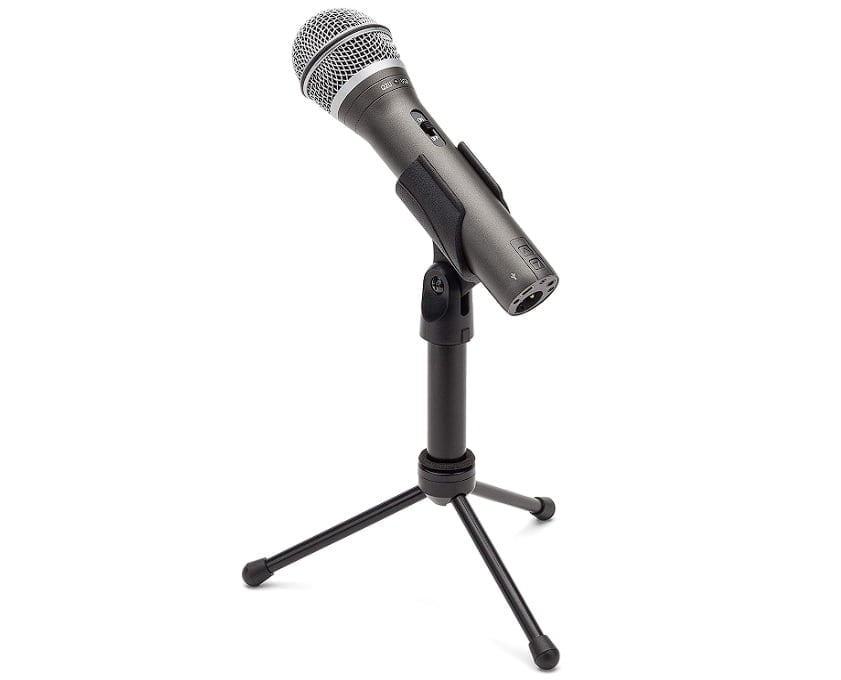
Samson Q2U
- Exceptional background noise rejection makes this perfect for shared spaces, dorm rooms, or untreated streaming areas.
- Best Plug-and-Play
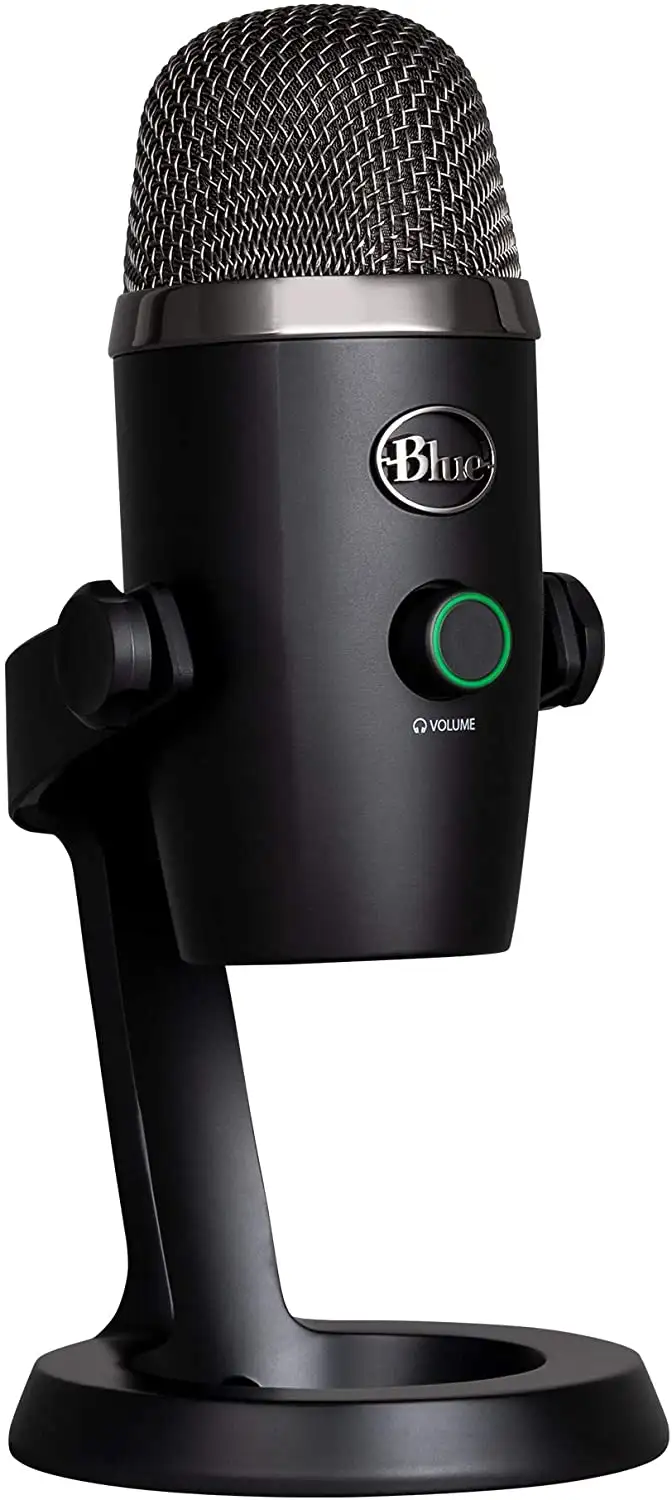
Blue Yeti Nano
- Professional results with minimal setup, excellent software integration, and one-touch mute functionality.
Quick Decision:
- Noisy room or shared space? → Samson Q2U
- Want best value and future-proofing? → Audio-Technica ATR2100x-USB
- Need simple setup with great features? → Blue Yeti Nano
Read the detailed reviews below to understand why these microphones excel and find the perfect match for your specific streaming setup.
Complete Reviews: Top 8 Budget USB Microphones
1. Audio-Technica ATR2100x-USB

Pros
- Exceptional audio quality with dynamic capsule design
- Both USB and XLR outputs (future upgrade path)
- Built-in headphone monitoring with volume control
- Excellent background noise rejection
- Professional build quality
Cons
- No built-in mute button
- Slightly more expensive than basic options
- Requires proper positioning for optimal sound
The ATR2100x-USB is a rare gem in the budget microphone world, offering features typically found in much more expensive setups. Its dynamic capsule design sets it apart from most USB microphones, which use condenser capsules. This means it naturally rejects background noise and room reflections, making it incredibly forgiving in untreated streaming spaces.
The dual USB/XLR connectivity is perhaps its most valuable feature. You can start streaming immediately via USB, but when you’re ready to upgrade to a professional audio interface, simply switch to XLR without buying a new microphone. The built-in headphone monitoring with separate volume controls for your voice and computer audio makes it easy to balance your stream mix.
Audio quality is crisp and clear with a natural frequency response that flatters most voices. The microphone requires positioning 2-4 inches from your mouth for optimal results, but once properly positioned, it delivers broadcast-quality audio that rivals microphones costing twice as much. The solid metal construction feels professional and can withstand years of daily streaming use.
2. Samson Q2U
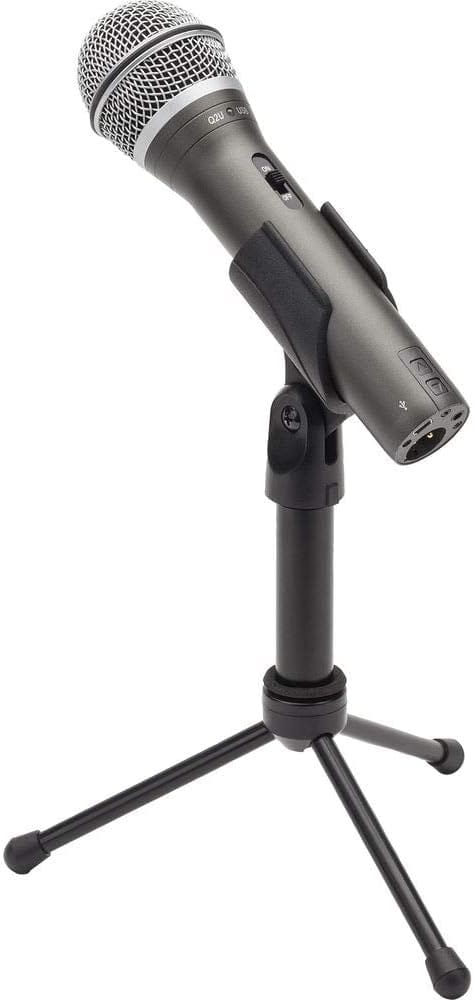
Pros
- Dynamic microphone excellent for loud environments
- USB and XLR connectivity
- Includes desktop stand and windscreen
- Broadcast-quality sound reproduction
- Minimal background noise pickup
Cons
- Requires close positioning (2-4 inches from mouth)
- No built-in mute button
- Desktop stand may not be ideal for all setups
The Samson Q2U is often called the “poor man’s SM7B,” and for good reason. This dynamic microphone delivers remarkably similar performance to broadcast industry standards at a fraction of the cost. Its supercardioid pickup pattern is incredibly tight, meaning it only captures sound directly in front of the capsule while rejecting noise from the sides and rear.
What makes the Q2U exceptional is its ability to perform in challenging acoustic environments. Whether you’re streaming from a dorm room, shared apartment, or space with hard surfaces and echo, this microphone maintains clarity and warmth. The dynamic design means it’s less sensitive than condenser microphones, requiring you to speak closer (2-4 inches), but this proximity actually helps create a more intimate, professional broadcast sound.
The build quality feels robust with a metal grille and solid construction that can handle the occasional drop. The included desktop stand is functional but basic – most serious streamers will want to pair this with a boom arm for optimal positioning. The dual USB/XLR connectivity provides excellent future-proofing, and the included windscreen helps reduce plosive sounds. Audio quality is rich and full with excellent midrange clarity that makes voices sound authoritative and engaging.
3. Blue Yeti Nano

Pros
- Crystal-clear cardioid pickup pattern
- One-touch mute with LED indicator
- Blue VO!CE software for real-time voice effects
- Solid desktop stand with tilt adjustment
- Great for voice and instrument recording
Cons
- Sensitive to room acoustics and background noise
- Desktop stand limits positioning flexibility
- Higher price point for this category
The Blue Yeti Nano represents the sweet spot in Blue’s microphone lineup – offering much of the original Yeti’s audio quality in a more compact, affordable package. The 14mm condenser capsule delivers crisp, detailed audio with excellent high-frequency response that makes voices sound clear and present. The cardioid pickup pattern is well-tuned to capture your voice while minimizing room noise, though it still requires some acoustic consideration.
What sets the Yeti Nano apart is its seamless integration with Blue’s ecosystem. The VO!CE software provides real-time voice processing including noise reduction, compressor, limiter, and EQ – essentially giving you a professional audio processing chain without needing separate software or hardware. The one-touch mute button with bright LED indicator is perfectly placed and responsive, making it easy to quickly silence your mic during streams.
The build quality is impressive with a sturdy metal construction and a weighted desktop stand that won’t tip over easily. The stand allows for smooth tilt adjustment to find the perfect angle. While primarily designed as a desktop microphone, it includes standard threading for boom arm mounting. The plug-and-play nature means you can be streaming within minutes of unboxing, making it ideal for streamers who want professional results without a steep learning curve. The frequency response is flattering for most voice types, though those with deeper voices may find it slightly bright.
4. Elgato Wave:1
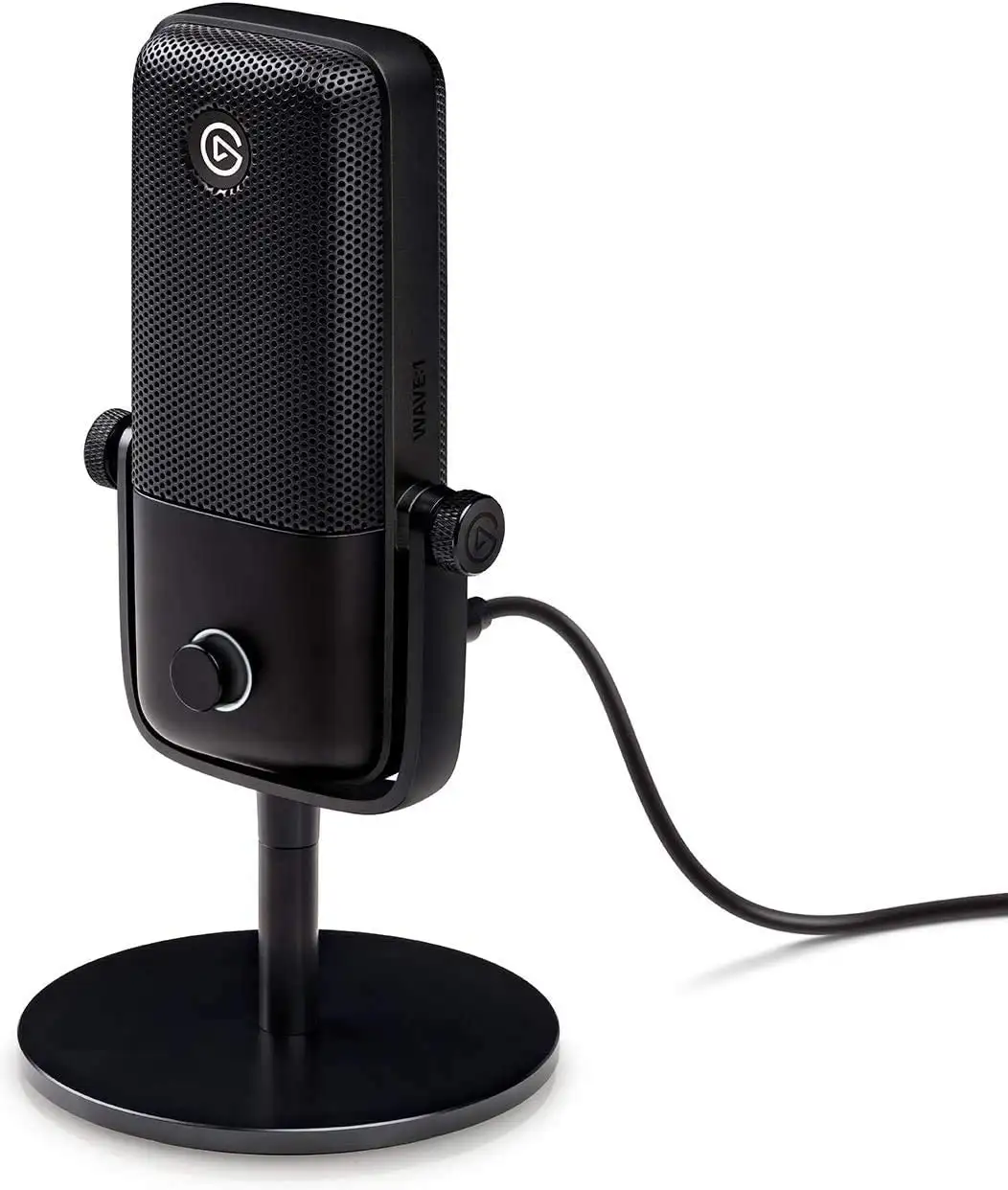
Pros
- Excellent audio quality with crisp highs
- Capacitive mute button with visual feedback
- Wave Link software for advanced mixing
- Boom arm adapter included
- Streamlined design fits any setup
Cons
- Software can be resource-intensive
- Requires acoustic treatment for best results
- Limited to USB-C connectivity
The Elgato Wave:1 was designed from the ground up specifically for content creators and streamers, and it shows in every detail. The 17mm condenser capsule delivers exceptionally clear audio with a bright, crisp character that cuts through game audio and music. The frequency response is tailored for spoken word, with a slight presence boost that makes voices sound engaging and professional.
The capacitive mute button is a standout feature – it’s touch-sensitive rather than requiring a physical press, and the LED ring provides clear visual feedback of your mute status. This is especially useful for streamers who frequently mute and unmute during gameplay. The cylindrical design is both attractive and functional, taking up minimal desk space while still providing excellent audio capture.
Where the Wave:1 truly excels is in its software integration. Wave Link transforms your streaming setup into a professional mixing console, allowing you to create separate audio channels for different sources, apply real-time effects, and create custom mixes for your stream versus your headphones. You can have separate volume controls for game audio, chat, music, and your microphone, with the ability to route different combinations to your stream and your personal monitoring.
The build quality is solid with a premium feel that matches Elgato’s other products. The included boom arm adapter makes mounting straightforward, and the USB-C connection provides reliable, high-quality digital audio transfer. However, the software can be demanding on system resources, and the condenser design means it works best in acoustically treated spaces.
5. Razer Seiren Mini
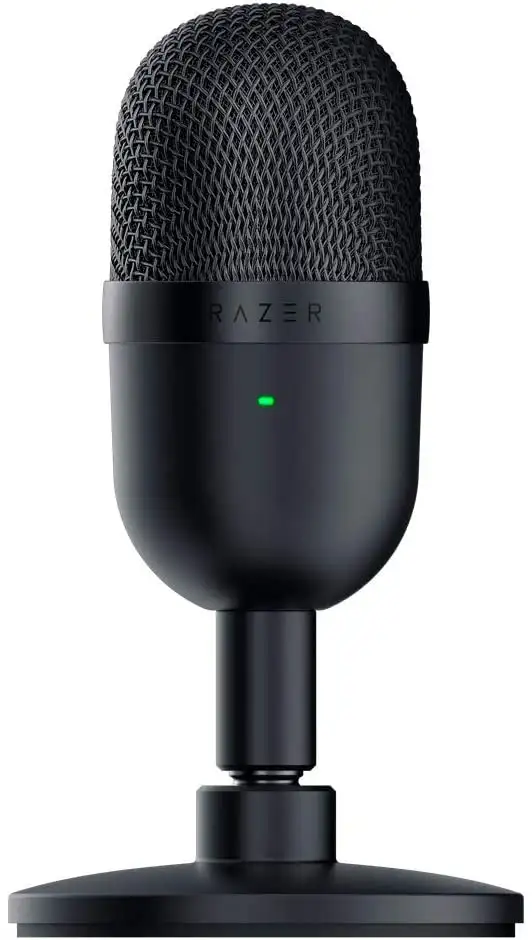
Pros
- Compact, desktop-friendly design
- Supercardioid pickup reduces side noise
- PC and console compatibility
- Affordable entry point
- Decent audio quality for the price
Cons
- No mute button or monitoring
- Limited positioning options
- Plastic construction feels less premium
- Sensitive to handling noise
The Razer Seiren Mini proves that you don’t need to spend a fortune to get respectable streaming audio. This ultra-compact microphone punches well above its weight class, delivering surprisingly good audio quality for its modest price point. The 14mm condenser capsule is the same size found in much more expensive microphones, and the supercardioid pickup pattern does an admirable job of focusing on your voice while rejecting background noise from the sides.
What makes the Seiren Mini particularly appealing is its simplicity and portability. At just 1.5 inches wide and weighing less than a pound, it takes up minimal desk space and can easily travel with a laptop setup. The fixed desktop stand positions the microphone at an optimal angle, though this does limit positioning flexibility compared to adjustable options.
The build quality is adequate for the price, with a mostly plastic construction that feels sturdy enough for regular use, though not as premium as metal alternatives. The integrated shock mount in the stand helps reduce vibration transfer, but you’ll want to avoid bumping your desk during recordings. Audio quality is clean and clear with good frequency response, though it lacks the warmth and richness of more expensive options.
The plug-and-play nature makes it incredibly easy to use – just connect the USB cable and start streaming. It works seamlessly with PC, Mac, PS4, and PS5, making it versatile for different gaming and streaming setups. While it lacks advanced features like mute buttons or software integration, it delivers exactly what budget-conscious streamers need: reliable, decent-quality audio without breaking the bank.
6. Rode PodMic USB

Pros
- Broadcast-quality dynamic microphone
- Excellent background noise rejection
- Built-in pop shield
- Professional look and feel
- Internal shock mounting reduces handling noise
Cons
- Requires boom arm for optimal positioning
- No built-in headphone monitoring
- Larger footprint than condenser mics
The Rode PodMic USB brings broadcast-quality audio to the streaming world with a design inspired by classic radio microphones. This dynamic microphone features a large diaphragm capsule that delivers rich, warm audio with excellent low-frequency response – perfect for streamers who want that professional radio host sound. The frequency response is specifically tuned for spoken word, with a presence boost that helps voices cut through background music and game audio.
What sets the PodMic USB apart is its incredible background noise rejection. The dynamic design combined with the built-in pop shield means you can stream in less-than-ideal acoustic environments while still maintaining professional audio quality. The internal shock mounting system virtually eliminates handling noise and vibration transfer, making it ideal for animated streamers who tend to move around or gesture while talking.
The build quality is exceptional – this is a microphone built to last decades of professional use. The all-metal construction feels substantial and premium, while the classic black finish gives any streaming setup a professional broadcast appearance. The integrated pop shield is perfectly positioned to reduce plosive sounds without affecting audio quality or requiring additional accessories.
However, the PodMic USB’s size and weight mean it really needs a boom arm for optimal positioning. The microphone is designed to be positioned close to your mouth (2-4 inches) and requires careful placement to achieve its full potential. While it lacks built-in headphone monitoring, the audio quality is so consistent and reliable that many streamers find they don’t miss this feature. The USB connectivity makes setup simple, though serious users might eventually want to explore the XLR version for even more flexibility.
7. HyperX QuadCast S

Pros
- Four selectable pickup patterns
- Customizable RGB lighting (16.8 million colors)
- Tap-to-mute with LED status indicator
- Built-in pop filter
- Compatible with PS4, PS5, PC, and Mac
Cons
- Higher price point
- RGB may be distracting in some setups
- Requires HyperX software for full functionality
- Condenser design picks up room noise
The HyperX QuadCast S is designed for gamers who want their microphone to be as impressive as their RGB gaming setup. Beyond the eye-catching customizable lighting, this is a genuinely capable microphone that delivers excellent audio quality for streaming and gaming. The large 14mm condenser capsule captures detailed, crisp audio with good frequency response across the vocal range.
The standout feature is the four selectable pickup patterns: stereo, omnidirectional, cardioid, and bidirectional. This versatility makes it suitable for solo streaming (cardioid), group discussions (omnidirectional), interviews (bidirectional), or even recording musical instruments (stereo). The tap-to-mute functionality is brilliantly implemented – simply touch the top of the microphone and the LED lighting changes to indicate mute status. This is much more convenient than physical buttons and has become a favorite feature among streamers.
The RGB lighting system offers 16.8 million colors and various effects, controlled through HyperX’s Ngenuity software. While some might find the lighting gimmicky, it’s tastefully implemented and can be turned off completely if desired. The software also provides EQ settings, noise reduction, and other audio enhancements, though it’s not as comprehensive as some competitors.
Build quality is solid with a sturdy metal construction and an integrated shock mount that reduces vibration transfer. The built-in pop filter is effective at reducing plosive sounds, though the condenser design means it’s still sensitive to room acoustics and background noise. The microphone works seamlessly across PC, Mac, PS4, and PS5, making it truly versatile for different gaming platforms. While it’s at the higher end of the budget category, the combination of audio quality, features, and gaming-focused design makes it worthwhile for serious gaming streamers.
8. Shure MV7

Pros
- Inspired by the legendary SM7B design
- Both USB and XLR connectivity
- Exceptional build quality and durability
- Natural, broadcast-quality sound
- ShurePlus MOTIV app for fine-tuning
Cons
- Highest price in this category
- Requires boom arm for optimal use
- May be overkill for casual streaming
The Shure MV7 represents the pinnacle of what’s possible in a “budget” USB microphone, bringing decades of broadcast engineering expertise to the streaming world. Inspired by the legendary SM7B used in professional radio stations and recording studios worldwide, the MV7 delivers remarkably similar audio quality at a more accessible price point. The dynamic capsule produces rich, warm audio with excellent midrange clarity that makes voices sound authoritative and engaging.
What makes the MV7 special is its versatility and future-proofing. The dual USB/XLR connectivity means you can start with simple USB connection and later upgrade to professional audio interfaces without replacing your microphone. The ShurePlus MOTIV app provides comprehensive control over EQ, compression, and limiting, essentially giving you a professional audio processing chain in software form.
The build quality is exceptional – this is a microphone built to professional broadcast standards that will likely outlast your streaming career. The all-metal construction feels substantial and premium, while the classic Shure design aesthetic gives any streaming setup instant credibility. The internal shock mounting and pop filter integration reduce the need for additional accessories, though you’ll definitely want a boom arm for optimal positioning.
Audio quality is natural and uncolored, providing an accurate representation of your voice without artificial enhancement. The frequency response is carefully tuned for spoken word with subtle presence boost that helps voices cut through dense audio mixes. The tight cardioid pattern provides excellent background noise rejection, making it suitable for challenging acoustic environments.
While it’s the most expensive option in this guide, the MV7 represents excellent value for serious streamers who want professional results and long-term reliability. It’s the kind of microphone that can grow with your streaming career, providing broadcast-quality audio whether you’re just starting out or running a professional content creation business.
Quick Comparison Guide
| Image | Microphone | Price |
|---|---|---|
 | Razer Seiren MiniBest for Beginners
| Price |
 | Audio-Technica ATR2100xBest for All-around use
| Price |
 | Samson Q2UBest for Noisy rooms
| Price |
 | Elgato Wave:1Best for Content creators
| Price |
 | Blue Yeti NanoBest for Plug-and-play
| Price |
 | Rode PodMic USBBest for Podcast style
| Price |
 | HyperX QuadCast SBest for Gaming
| Price |
 | Shure MV7Best for Professionals
| Price |
Setup Tips for Better Audio
Positioning: Place your microphone 6-8 inches from your mouth for condenser mics, 2-4 inches for dynamic mics.
Room Treatment: Even budget acoustic panels or blankets can dramatically improve your audio quality.
Gain Settings: Start with low gain and increase gradually to avoid distortion and background noise.
Pop Filters: If not included, invest in a pop filter to reduce plosive sounds (P’s and B’s).
Boom Arms: Desktop stands work, but boom arms offer better positioning and reduce vibration transfer.
When to Upgrade
Start with a budget option, but consider upgrading when:
- You’re earning money from streaming
- Your room acoustics improve significantly
- You need XLR connectivity for professional mixing
- Your current microphone becomes a limiting factor
Final Recommendations
For absolute beginners: Razer Seiren Mini offers the lowest barrier to entry.
For most streamers: Audio-Technica ATR2100x-USB provides the best balance of quality, features, and future-proofing.
For serious content creators: Blue Yeti Nano or Elgato Wave:1 offer professional results with advanced software features.
For challenging environments: Samson Q2U or Rode PodMic USB excel in noisy or untreated rooms.
Remember, the best microphone is the one you’ll actually use consistently. Focus on finding something within your budget that meets your immediate needs, then upgrade as your streaming journey progresses.
Frequently Asked Questions
-
Do I need an expensive microphone to start streaming?
Absolutely not. Many successful streamers started with budget microphones under $100. Audio quality matters more than price – a $60 dynamic microphone in a noisy room will sound better than a $200 condenser microphone picking up background noise. Start with something affordable that fits your environment and upgrade as your streaming grows.
-
What’s the difference between USB and XLR microphones?
USB microphones plug directly into your computer and are ready to use immediately – perfect for beginners. XLR microphones require an audio interface but offer more flexibility and upgrade potential. Several microphones in our guide (ATR2100x-USB, Q2U, MV7) offer both connections, giving you the best of both worlds.
-
Should I choose a dynamic or condenser microphone?
Dynamic microphones (like the Q2U, ATR2100x-USB) are less sensitive and naturally reject background noise – perfect for noisy environments or untreated rooms. Condenser microphones (like the Yeti Nano, Wave:1) are more sensitive and capture detail beautifully but require quieter spaces and often benefit from acoustic treatment.
-
How important is a mute button?
Very important for live streaming. Mute buttons prevent embarrassing moments during streams and make it easy to have private conversations without stopping your broadcast. However, you can also use software muting or push-to-talk if your microphone lacks a physical mute button.
-
Do I need acoustic treatment for my streaming room?
It depends on your microphone choice and room. Dynamic microphones are much more forgiving and work well in untreated spaces. Condenser microphones benefit greatly from acoustic treatment – even hanging blankets or adding soft furnishings can make a significant difference. Start streaming first, then improve your room acoustics if needed.
-
Can I use these microphones for gaming consoles?
Most USB microphones work with PC and Mac, but console compatibility varies. The HyperX QuadCast S specifically supports PS4/PS5, while others may require additional setup. Check the manufacturer’s specifications for your specific console before purchasing.
-
How close should I position my microphone?
Dynamic microphones: 2-4 inches from your mouth for optimal sound quality and background noise rejection. Condenser microphones: 6-8 inches away to avoid overwhelming the sensitive capsule while maintaining good audio quality. Always speak across the microphone rather than directly into it to reduce breath sounds.
-
What accessories do I need besides the microphone?
Essential accessories include:
Boom arm: Provides better positioning and reduces vibration transfer
Pop filter: Reduces plosive sounds (P’s and B’s) if not built-in
Shock mount: Isolates the microphone from vibrations (often included)
Windscreen: Reduces breath noise and protects the capsule -
When should I upgrade from my current microphone?
Consider upgrading when:
Your current microphone becomes a limiting factor in your stream quality
You’re earning money from streaming and can justify the investment
Your room acoustics have improved significantly
You need features your current microphone lacks (XLR connectivity, better software, etc.) -
Can I use streaming microphones for music recording?
While these microphones are optimized for voice, many work well for basic music recording. The Blue Yeti Nano and HyperX QuadCast S with multiple pickup patterns are particularly versatile. However, dedicated studio microphones will generally perform better for serious music production.
-
How do I reduce echo and room noise?
Choose a dynamic microphone if possible (Q2U, ATR2100x-USB, PodMic USB)
Add soft furnishings like curtains, carpets, or blankets to your room
Position yourself away from hard surfaces like walls and windows
Consider acoustic panels or even a simple blanket fort around your streaming area
Use noise reduction software like OBS filters or your microphone’s included software -
What’s the best microphone for someone just starting out?
The Razer Seiren Mini offers the lowest barrier to entry with decent quality, while the Audio-Technica ATR2100x-USB provides the best long-term value with room to grow. Choose based on your budget and how serious you are about streaming.

Leave a Reply